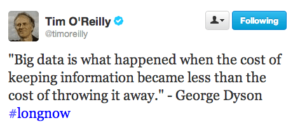If you’ve ever used a computer, chances are the person who built that computer has used /dev/null.
/dev/null is the unsung Unix hero, dutifully discarding exhaust from noisy programs. It’s like a programmer’s Recycle Bin, with one major difference — there’s no “Restore”.
Ironically, it’s exactly that limitation that’s thrust /dev/null into the spotlight as a new alternative to traditional big data management.
Why now? Why /dev/null?
Because of this tweet:

Eluding data is now more expensive than collecting it. Gartner estimates that data-avoidance costs enterprise companies $41B annually. And that number is growing fast.
Remy Rafael, a long-time /dev/null contributor, claims he and his co-committers saw it coming all along:
“[Back in the 70’s] everyone became obsessed with storing larger and larger quantities of data. We were not impressed. We felt that learning how to ditch the bad bits would eventually be more important than storing the good ones.”
Today /dev/null stands uniquely prepared for the data deluge. For their foresight the team has been showered with praise. But how did they hold out against popular opinion for so long?
“We won the community over by sticking to three core principles…” explains Rafael:
- state doesn’t scale
- reads are expensive but beer is cheap
- sharding sounds like an accident
“Overall we focused on speed and stability.”
One thing well — the design philosophy of /dev/null
Rafael dives deeper during a recent interview:
RR — “It’s less of a database than people realize. For starters, /dev/null doesn’t do reads.”
JD — “Elaborate.”
RR — “The dirty secret of the database world is that while reads are expensive, most query results are looked at for only a second or two.”
A shocking realization. Rafael continues:
RR — ”We said forget it. We know writes. Let’s just do writes.”
The decision to forego reads puts /dev/null in a rare category of databases known as “write-only”. And write-only is a term that makes data architects log off and listen.
What’s so special? For starters, write-only is the only known database architecture capable of constant-time operations at infinite scale. This means there are no theoretical limits to what it can do, or how fast it can run.
Over the last three decades /dev/null has handled zettabytes of write-only data flawlessly:
“I can’t begin to fathom the things people have put in there. And because it’s write-only neither can you.”
Earl Fetcher, co-author of ‘The Stringularity’
Due to it’s impressive scalability even enterprise vendors are taking note:
“No-SQL databases were a good start. But just removing SQL isn’t enough. We need to remove everything. We need a truly No-Database database.”
Ben Shardin, CTO of Teracle
Announcing /dev/null/as/a/service
You don’t have to be on an enterprise plan to take advantage of Keen IO’s /dev/null API. It’s 100% free to all of our current and future customers.
Here’s what you get:
- REST API. In other words “>/dev/null 2>&1” for humans.
- Unlimited events. Unlimited queries. (Note that all queries return 0)
- Have you ever put a black hole inside of another black hole? Keen IO makes it impossible to accidentally delete /dev/null.
Sample code (paste in your terminal):
curl "https://api.keen.io/dev/null" -d "byebyebirdie"
Now prove that it worked:
curl "https://api.keen.io/dev/null"
(No terminal? Get the result in your browser.)
Getting rid of annoying data has never been so easy!
Let’s recap
Losing data costs your company money. As always, we suggest you catch all the interesting bits and use them to increase your awesomeness — that’s Keen IO classic.
For those other bits, consider our cost-effective data-diverting alternative — Keen IO /dev/null.
As always, drop by if you have questions!



